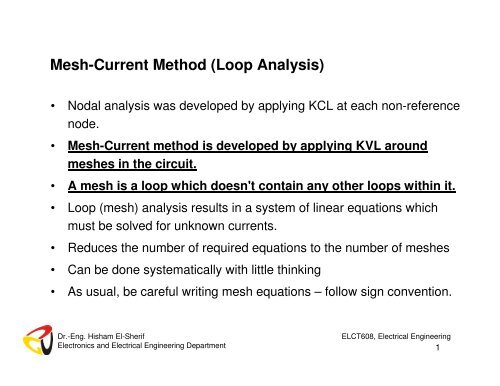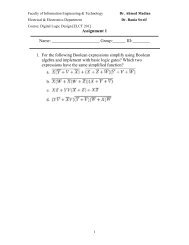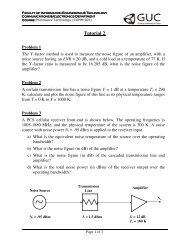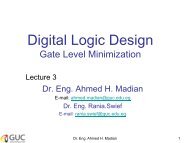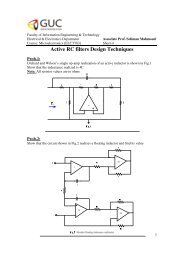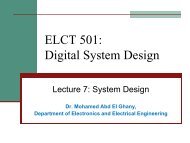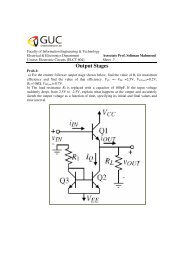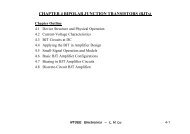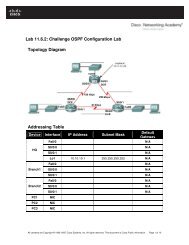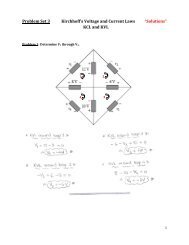Mesh-Current Method (Loop Analysis)
Mesh-Current Method (Loop Analysis)
Mesh-Current Method (Loop Analysis)
Create successful ePaper yourself
Turn your PDF publications into a flip-book with our unique Google optimized e-Paper software.
<strong>Mesh</strong>-<strong>Current</strong> <strong>Method</strong> (<strong>Loop</strong> <strong>Analysis</strong>)• Nodal analysis was developed by applying KCL at each non-referencenode.• <strong>Mesh</strong>-<strong>Current</strong> method is developed by applying KVL aroundmeshes in the circuit.• A mesh is a loop which doesn't contain any other loops within it.• <strong>Loop</strong> (mesh) analysis results in a system of linear equations whichmust be solved for unknown currents.• Reduces the number of required equations to the number of meshes• Can be done systematically with little thinking• As usual, be careful writing mesh equations – follow sign convention.Dr.-Eng. Hisham El-SherifElectronics and Electrical Engineering DepartmentELCT608, Electrical Engineering1
•Powerful analysis method which applies KVL to find unknown currents.•It is applicable to a circuit with no branches crossing each other.no branchesCrossingDr.-Eng. Hisham El-SherifElectronics and Electrical Engineering DepartmentELCT608, Electrical Engineering2
DefinitionsA mesh is a loop which does not contain any other loops within it. A+-i 4i 5 i 1i 2Bi gCi 3 Dr.-Eng. Hisham El-SherifElectronics and Electrical Engineering DepartmentELCT608, Electrical Engineering3
Steps of <strong>Mesh</strong> <strong>Analysis</strong>Step1Identify the number ofbasic meshes.Step 2Assign a current to each mesh.Dr.-Eng. Hisham El-SherifElectronics and Electrical Engineering DepartmentELCT608, Electrical Engineering4
Step 3Apply KVL around each loop to getan equation in terms of the loop currents.Step 4Solve the resulting system of linear equations.As an exampleV 1 + I 1 R 1 + (I 1 - I 2 ) R 3 = 0I 2 R 2 + V 2 + (I 2 -I 1 ) R 3 = 0Dr.-Eng. Hisham El-SherifElectronics and Electrical Engineering DepartmentELCT608, Electrical Engineering5
ExampleUse mesh analysis to find the current i oSolutionWe apply KVL to the three meshesFor mesh 1Divide by 2For mesh 2Divide by 2Dr.-Eng. Hisham El-SherifElectronics and Electrical Engineering DepartmentELCT608, Electrical Engineering6
For mesh 3at node ABy SubstitutionDivide by 2Dr.-Eng. Hisham El-SherifElectronics and Electrical Engineering DepartmentELCT608, Electrical Engineering7
Cases to be considered for <strong>Mesh</strong> <strong>Analysis</strong>Case IA current source exists only in one meshset i 2 = −5A and write a mesh equation for the othermeshFor <strong>Loop</strong> 1-10 + 4i 1 + 6(i 1 -i 2 ) = 0For <strong>Loop</strong> 2i 2 = - 5A(No need to write a loop equation)Dr.-Eng. Hisham El-SherifElectronics and Electrical Engineering DepartmentELCT608, Electrical Engineering8
Case IIA current source exists between two meshesExclude this partDr.-Eng. Hisham El-SherifElectronics and Electrical Engineering DepartmentELCT608, Electrical Engineering9
a supermesh was created byexcluding the current source and anyelements connected in series with it,Why???Because mesh analysis applies KVL—we do not know thevoltage across a current source in advance.A supermesh results when two meshes have a (dependentor independent) current source in common.Dr.-Eng. Hisham El-SherifElectronics and Electrical Engineering DepartmentELCT608, Electrical Engineering10
Applying KVL to the supermeshi 1 i 2Apply KCL to a node in the branch where the two meshes intersect.Dr.-Eng. Hisham El-SherifElectronics and Electrical Engineering DepartmentELCT608, Electrical Engineering11
Case III<strong>Mesh</strong> with Dependent SourcesSolve forI xi x = i 1 - i 2-75 + 5i 1 + 20(i 1 -i 2 ) = 010i x + 20(i 2 -i 1 ) + 4i 2 = 0Solve the two equations-75 + 5i 1 + 20(i 1 -i 2 ) = 0 …………………(1)10(i 1 -i 2 ) + 20(i 2 -i 1 ) + 4i 2 = 0 …………….(2)theni 2 = 5Ai 1 = 7ADr.-Eng. Hisham El-SherifElectronics and Electrical Engineering DepartmentELCT608, Electrical Engineering12
Example:Use the mesh-current method to find i oDr.-Eng. Hisham El-SherifElectronics and Electrical Engineering DepartmentELCT608, Electrical Engineering13
Solutionmeshes 1 and 2 form a supermeshmeshes 2 and 3 form a supermeshDr.-Eng. Hisham El-SherifElectronics and Electrical Engineering DepartmentELCT608, Electrical Engineering14
Applying KVL to the larger supermesh,Dr.-Eng. Hisham El-SherifElectronics and Electrical Engineering DepartmentELCT608, Electrical Engineering15
For the independent current source, we apply KCL to node PDr.-Eng. Hisham El-SherifElectronics and Electrical Engineering DepartmentELCT608, Electrical Engineering16
For the dependent current source, we apply KCL to node Q:Dr.-Eng. Hisham El-SherifElectronics and Electrical Engineering DepartmentELCT608, Electrical Engineering17
Applying KVL in mesh 4,Dr.-Eng. Hisham El-SherifElectronics and Electrical Engineering DepartmentELCT608, Electrical Engineering18


